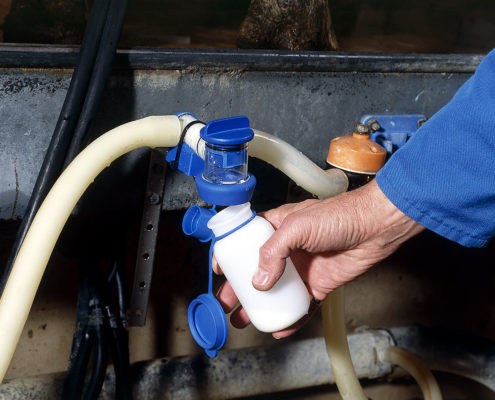Individual Cow Milk Sampling
Individual cow milk samples can be tested for cell count, butterfat and protein. Some herds carry out milk progesterone testing. In addition, some laboratories can carry out tests on Johne’s Disease, which causes a wasting disease in dairy cows and is invariably terminal, and in the future PCR testing for individual bacteria might become available with regular testing.
Most milk recording schemes test cows monthly while some other farmers record at six or eight week intervals. Some herds collect milk samples from the foremilk or the first ten squirts of milk prior to unit attachment. These samples are not representative of the entire milking. Foremilk has a much higher cell count. It is also difficult to ensure that you have a balanced amount of milk from each of the four quarters. For this reason, it is essential that you collect a representative sample and so using a device such as the AMBIC MILK SAMPLER ensures that you have a sample that reflects the entire milking.
Individual cow cell count testing
Cell counting provides a numerical result and indicates the level of subclinical infection in the cow on the day of testing. Cell counts are important for a number of reasons;
- EU legislation requires all milk sold off farm to have a cell count of under 400
- Most milk buyers impose penalties for high cell count bulk milk. The threshold varies country by country, but most farmers with cell counts over 200 to 250 will be paid a reduced milk price.
- A high cell count means subclinical infection and can have a significant impact on yield
- A high cell count cow is a reservoir of infection for the rest of the herd and so specific management actions can be taken including milking last, dry off early, special dry cow therapy, bacteriology to identify the cause of the infection etc.
Herds which have problems with high cell counts are advised to test cows on a regular basis. The aim is to have a herd cell count well below the cell count payment penalty level with a safety net whereby if a few samples are high, the payment average does not exceed the penalty threshold.
Milk quality components
Samples can be tested for butterfat and protein. The information can be used with herd fat and protein levels to identify cows with low readings. However, one has to be aware that there can be significant variation in test results. Protein levels are a useful indicator of energy and so if cows in early lactation are the ones with low milk protein, then energy intake should be reviewed. Some farmers and advisors will analyse fat and protein levels on their own or in combination, but always taking into consideration the herd results.
Milk progesterone testing
Milk progesterone testing is a very accurate way of detecting cows which are NOT pregnant. Cows with low milk progesterone levels are definitely not pregnant. Many farmers carry out these tests between 18 and 24 days following the previous service. If the test result is low then you know with 100% certainty that this animal is not pregnant, a heat detection device such as AI READY or AI ALERT can be put on the cow to pick up bulling behaviour when she can be served.
A high reading suggests that the animal could be pregnant and this would be confirmed by pregnancy diagnosis. Unfortunately, milk progesterone testing cannot replace pregnancy testing as you can get false positives from cows with cystic ovaries and prolonged estrus cycles.
Additional tests
Some laboratories can carry out testing to identify the presence of antibodies for Johne’s Disease. This helps to decide if animals are infected or free from the disease. Testing is not 100% accurate, but using information from a number of tests helps to build up a history which can be taken with individual cow history.
In the future, it might be possible to request that milk samples from the top ten high cell count cows are also tested for mastitis bacteria using PCR testing. PCR testing is where bacteria are identified using DNA technology. Each individual bacteria has its own DNA make up, or number plate, from which it can be identified with 100% accuracy. This could be very useful in the control of cell counts.
There are further tests which some individual farmers or their veterinarian might wish to carry out and this is likely to increase with the improving laboratory techniques and range of tests that are being currently developed.
Click here for further details on the Ambic Milk Sampler.





